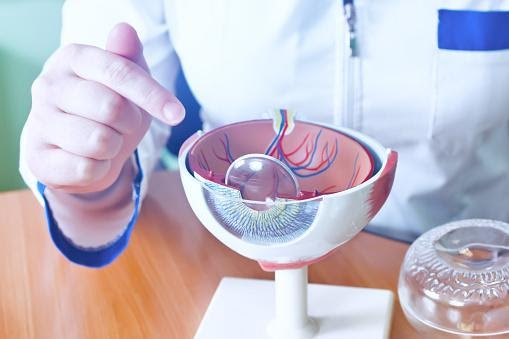
Cataract surgery is an extremely frequent outpatient treatment that is typically safe. However, like with any surgical operation, there is a possibility of complications.
The body is made up of a variety of proteins that comprise the tissues, muscles, and even the blood. Particular proteins can accumulate in certain locations over time or as a result of certain damage.
When cataracts develop in your eye, proteins in the lens of the eye degrade and form clumps, resulting in cloudiness that can impair or impede vision.
The solution is a surgical procedure in which the lens is removed and replaced with an artificial lens. When cataracts begin to impair everyday activities, your physician may propose cataract surgery.
Complications include the following: edema; discomfort; infection; and adverse responses to anesthetic medicines.
Complications
Any surgical operation might result in complications. There are a number of particular problems associated with cataract surgery that your surgeon will be aware of.
1. Discomfort
Pain is a common complication of the majority of surgical operations. Because cataract surgery primarily affects the surface layers of the eye, over-the-counter pain medications are usually sufficient. Consult your physician if the discomfort persists or worsens. This might indicate the presence of a more significant issue.
2. Suffocation
Suprachoroidal hemorrhage can develop during cataract surgery in patients with diabetes, hypertension, or other pre-existing disorders. Although this problem is uncommon, it requires prompt attention to avert visual loss.
3. Contamination
Most surgeries involve some risk of infection due to surgical instruments, the surgeon’s skill, or postoperative wound care.
Endophthalmitis is a kind of infection that may occur following cataract surgery. It is, however, uncommon, occurring in less than 0.5 percent of cataract procedures.
4. Persistent or new vision impairments
Cataract surgery is not always effective, and you may continue to have vision difficulties or worsen your vision following surgery. This is an uncommon complication, although it is more prevalent in patients who had other eye disorders in addition to cataracts prior to surgery.
Double vision, which is often transient, can also occur following eye surgery as your brain adjusts to a new, sharper image.
5. Floaters
Floaters are microscopic protein or collagen particles that can enter your field of vision and produce shadows. While floating does not usually require treatment, it can occasionally be an indication of a more serious disease.
6. Itchy or dry eyes

Dryness and irritation are frequent throughout the healing process. Itchy, gritty, or dry eyes are possible. Your doctor may prescribe lubricating eye drops to alleviate this issue. Consult your doctor on the appropriate time to use eye drops following cataract surgery.
7. Allergy symptoms
General anesthesia is seldom used during cataract surgery and is mainly reserved for young patients. To numb the eye, either topical anaesthetic provided by eye drops or local anesthetic administered via injection may be employed.
Consult your physician before surgery if you are allergic to any medications.
8. Irritation
While not considered a real complication, but rather an expected outcome, “cell and flare” refers to inflammation induced by minor damage to the eye following an s.
When your surgeon makes contact with your eye, a tiny number of white blood cells or protein may accumulate in the front chamber, resulting in impaired vision or increased sensitivity to light. This is a transient ailment that can be addressed with topical steroids. You can read about 8 Cataract surgery tips you should know of by visiting http://lasiksurgeryrx.com/8-cataract-surgery-tips-you-should-know-of/
9. Edema of the cornea
Again, this is a normal outcome of surgery, but one that may be cause for concern. Swelling of the cornea can occur anywhere following surgery but is more common near the location of the incision. Topical steroids can be used to alleviate edema in this situation.
10. Heightened pressure
Up to half of patients who undergo cataract surgery will feel an increase in ocular pressure following the treatment, however, this often resolves within 24 hours.
Following surgery, persistent difficulties with increased or reduced eye pressure may be connected to other eye disorders, such as glaucoma.
11. Prolapse of the iris
In rare instances, surgery may result in iris trauma, leading to a prolapsed iris. This is occasionally associated with inadequate wound closure or healing at incision sites, or with prolonged periods of elevated intraocular pressure.
Sometimes the iris can be moved, but in more severe situations, more surgery will be necessary.
12. Leaks from wounds
Wound leaks are another uncommon problem that occurs when fluid seeps around the incision sites. These leaks are identified with fluorescein dye and are often treated with steroids.
Your doctor may put a bandage contact lens or undertake corrective surgery in some circumstances to resolve the issue.
13. Syndrome of the toxic anterior segment
Severe swelling and discomfort in the days following cataract surgery may be indicative of this condition. Toxic anterior segment syndrome is an extremely uncommon illness that is frequently caused by infected surgical instruments or eye drops.
This illness, which can be difficult to distinguish from endophthalmitis, is treated with high dosages of steroids and analgesics.
14. Acute endophthalmitis in its early stages
This is another form of infection that can arise three to seven days after surgery and causes swelling and discomfort. Steroids are ineffective in treating this eye infection. It is often treated with antibiotics or sent to a specialist.
15. Lens fragments retained
In certain instances, little fragments of your native lens may remain following cataract surgery. These symptoms may manifest themselves days or even years later in the form of:
- Blurred vision
- Sensitivity to light
- Tearing
- Flushing
If lens pieces are found to be the source of the problem, they should be surgically removed – ideally by the physician who conducted the treatment originally.
16. Opacification of the posterior capsular layer
This is a rather common late complication that occurs in between 14 and 60% of cataract surgery procedures. This disorder, which is more prevalent in patients with diabetes or who have had prior eye surgery, leads in the production of microscopic particles stuck in the layer behind the lens.
These particles combine to produce small transparent bubbles known as Elschnig’s pearls. This issue can be resolved with a surgery called laser posterior capsulotomy.
17. Edema cystoid macular
This is the most often occurring complication of most cataract surgery procedures and can occur up to eight weeks following the treatment. It happens in around 1% to 2% of all cataract operations.
Swelling is caused by an accumulation of fluid in the eye, which can impair vision. Topical steroid and nonsteroidal medications are typically used to treat this disease, which can last up to two months.



